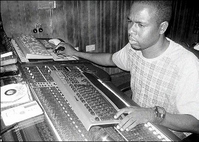IN THE STUDIO: Rory at the One Pop controls
Published: Sunday | September 20, 2009

Orville 'Rory' Baker at the controls at One Pop studio on Red Hills Road. - Photo by Mel Cooke
Anywhere on Red Hills Road, St Andrew, close to noon any day (except maybe Sunday) is a busy place. Not to mention hot. However, up two flights of steps and through three doors, there is a totally different atmosphere. It is cool, the lighting muted and Orville 'Rory' Baker is at the controls in the Nuendo-outfitted One Pop studio.
He is introducing The Sunday Gleaner to the nuances of mixing a song as he works on a couple roots reggae tracks by Canadian singer Nardo, produced by Leroy Brown. Emphasis on 'introducing'; learning the subtleties involved would take some of the 14 years Rory has spent at the mixing boards. He explains that a song is mixed "to get clarity and separation".
bringing life
"Just think of it as painting a picture. You have to make sure the building is highlighted. Everything around it highlights the building. Things in the background, around it and so on. If you just paint the building as one it is dull. You need the trees in the background, the hills ...," he said.
Summing up his job as a mixing engineer, Rory says "you bring to life the energy of the musicians, the vocals. If everything is playing one time you have a lot of confusion." A good recording, he says, leads to a good mix. But there are times he "gets some stuff and I have to work magic". The songs down for more mixing - some work had been done before - are Let's Party, So You Think and Get Rid of the Devil and he works on the first, turning to face the mixing board and his demeanour totally changes as he gets down to the business at hand.
Nardo sings, "come on and let's party/play a song and let's party ... why worry about things you can't change/some things you can't rearrange/give thanks to the Almighty ...".
Along the lower edge of the screen, the various instruments in the song are identified, the column above them giving its sonic information and allowing for adjustments. Among the components are a wood block, chimes, piano, bass, funde, cabasa and, of course, the various vocals - lead and harmony.
One thing is immediately clear - Rory's ears are vital equipment. He turns his head to one side, listens, shoulders and back moving to the rhythm as they do throughout most of the session, and makes an adjustment. The Sunday Gleaner does not quite hear the difference, but it is obvious that Rory does. A part of the mix is taking out and then reintroducing the drums, a popular approach to roots reggae.
making adjustments
Rory takes out the drums before Nardo sings "we need a happy song", then brings them back in after a line which ends in "tonight".
In the fully computerised recording set-up, he changes screens and makes adjustments, then sets up to mix Get Rid of the Devil. On this song, at one point Rory turns it down very low and listens carefully, making adjustments to the wood block, sweeping the mouse left and right throughout the song to set up a particular effect.
nearing perfection
Rory is in a musical world of his own, which includes talking to himself at one point after he does not quite get the moment, although his hand makes an elaborate move on the keyboard. "Come on!" Rory says, and does it over again.
He applies effects too, compressing the lead vocal and the wood block, adjusting limiter and output in the process. The mixing process can be highly repetitive; Rory plays the background vocalists singing "everybody's gonna feel right" several times, listening and listening - and there is some teeth hissing as well, as things are not quite the way they should be.
They soon are, though, and he applies a little individual equaliser, then a stereo equaliser on it all and the morning of mixing is just about done.



















